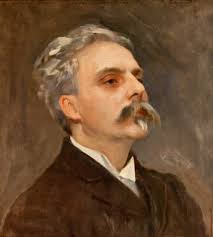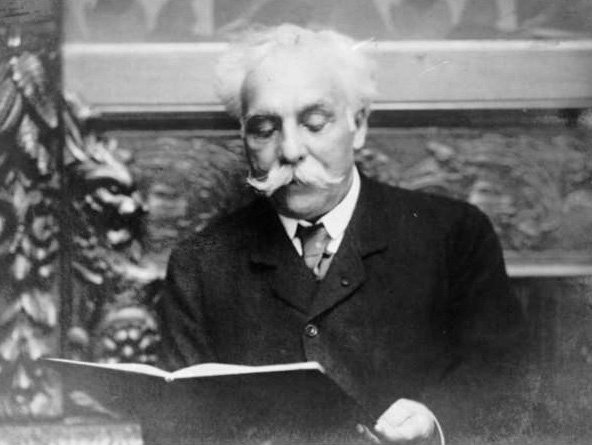Gabriel Fauré: A Life in Music
Early Life and Education (1845–1865)
Gabriel Urbain Fauré was born on May 12, 1845, in Pamiers, a small town in the south of France. The youngest of six children, Fauré showed an early affinity for music, often playing the harmonium in the local church before the age of five. Recognizing his talent, his father sent him to study at the newly founded École de Musique Classique et Religieuse (later known as the École Niedermeyer) in Paris at the age of nine.
At the school, Fauré studied piano, organ, and composition under renowned teachers, including Camille Saint-Saëns, who became a lifelong friend and mentor. This period laid the foundation for Fauré’s unique musical voice—rooted in tradition yet filled with innovation.

Early Career and Personal Struggles (1866–1880)
After graduating in 1865, Fauré began working as an organist in various Parisian churches. He also served briefly in the Franco-Prussian War (1870–1871). Returning to civilian life, he became choirmaster at the Église de la Madeleine in Paris, eventually rising to the position of chief organist.
Although deeply involved in church music, Fauré’s ambition was always to compose. His early works, including the First Violin Sonata, the Ballade in F-sharp major, and several mélodies (French art songs), attracted critical acclaim, though his music remained largely unknown to the broader public.
Fauré’s personal life was often marked by melancholy. In 1877, his engagement to Marianne Viardot (daughter of the famed singer Pauline Viardot) ended in heartbreak, a blow that echoed in the poignant tone of his music.
Artistic Maturity and Recognition (1880–1905)
During the 1880s and 1890s, Fauré’s reputation steadily grew. His Requiem in D minor (Op. 48), composed between 1887 and 1890, became one of his most celebrated works. Unlike the dramatic and fearsome settings of the Requiem by other composers, Fauré’s version is introspective, serene, and filled with a gentle sense of hope.
Fauré also contributed significantly to the world of chamber music, writing piano quartets, string quartets, and cello sonatas that are now staples of the repertoire. His mélodies—including Clair de lune, Après un rêve, and Les roses d’Ispahan—elevated the genre to new artistic heights.
In 1896, Fauré was appointed professor of composition at the Paris Conservatoire, where he taught students who would become some of the 20th century’s most influential composers, including Maurice Ravel, George Enescu, and Nadia Boulanger.
Later Years and Legacy (1905–1924)
In 1905, Fauré became director of the Paris Conservatoire, where he initiated important reforms and championed modern music. Despite increasing deafness, he continued to compose prolifically. His later works—such as the Piano Trio in D minor, the Second Cello Sonata, and the String Quartet in E minor—display subtle harmonic innovation and emotional restraint.
Fauré’s music, often understated and refined, defied the grandeur of Romanticism and anticipated the clarity and elegance of French modernism. His compositions are marked by lyricism, rich modal harmonies, and a keen sense of structure and economy.
Gabriel Fauré died on November 4, 1924, in Paris. His funeral, held at the Église de la Madeleine, was attended by the elite of the French cultural world. He was buried in the Cimetière de Passy, leaving behind a profound legacy.
Fauré’s Influence on Music History
Fauré stands as a central figure in French music. His work bridged the gap between Romanticism and Impressionism, influencing Debussy, Ravel, and generations of composers who sought a more subtle, introspective musical language. His innovations in melody, harmony, and form deeply shaped French music and continue to resonate with musicians and listeners today.
Fauré’s contribution is perhaps best appreciated in the intimacy of the piano, the voice, and chamber ensembles, where his quiet genius speaks with eloquence and emotional depth.
Famous Works by Gabriel Fauré
- Requiem in D minor, Op. 48
- Clair de lune (from Deux Mélodies, Op. 46)
- Après un rêve, Op. 7, No. 1
- Pavane, Op. 50
- Élégie for Cello and Piano, Op. 24
- Dolly Suite, Op. 56 (for piano four-hands)
- Nocturnes for Piano (13 total)
- Ballade in F-sharp major, Op. 19
- String Quartet in E minor, Op. 121 (his final work)
Did You Know?
- Fauré once described his own Requiem as “a lullaby of death” rather than a vision of judgment.
- Despite his growing deafness in later life, Fauré continued composing in silence, relying on his inner ear.
- He was known for his gentle demeanor, refined taste, and sharp wit.
- Fauré’s influence reached well into the 20th century, thanks to his roles as teacher and director at the Paris Conservatoire.
Conclusion
Gabriel Fauré’s life was one of quiet revolution. With elegance, depth, and originality, he shaped the sound of modern French music and left an indelible mark on the history of classical music. His works continue to captivate audiences with their subtle beauty, poetic spirit, and emotional honesty.
Thank you for visiting our site. Let Fauré’s music inspire your journey into the rich world of classical composition.

Comments are closed